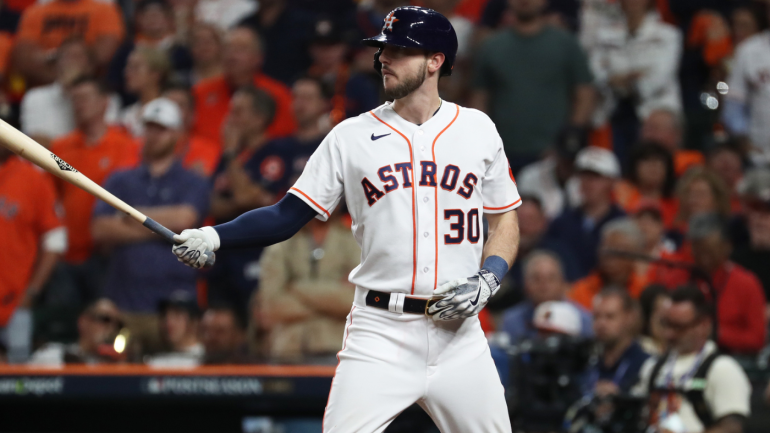
Houston Astros general manager Dana Brown confirmed during an MLB Network Radio appearance over the weekend that he intends to discuss a long-term extension with outfielder Kyle Tucker. Brown's comments come a week after signing Jose Altuve to a new five-year pact worth $125 million that will keep the star second baseman in Houston for the rest of his career.
Tucker, 27, is scheduled to qualify for free agency after the 2025 campaign. In parts of six big-league seasons to date, he's batted .272/.345/.507 (133 OPS+) with 102 home runs, 83 stolen bases, and an estimated 18.3 Wins Above Replacement, according to Baseball Reference's estimates. He's a two-time All Star who won a Silver Slugger Award last year and a Gold Glove Award in 2022. It's fair to classify him as a premium talent, one who should be in line for a lucrative long-term deal one way or another.
While it's unclear what kind of financial terms Tucker would require to forgo free agency, we can make an educated guess based on history. To wit, here's a look at every four-plus-year extension signed by an outfielder with similar service time (between four and five years) since the end of the 2010 season:
| Player | Signed in | Years | Total money | AAV |
|---|---|---|---|---|
Nov. 2014 | 13 | $325 million | $25 million | |
April 2023 | 7 | $100 million | $14.3 million | |
April 2011 | 5 | $105 million | $21 million | |
March 2012 | 4 | $37.5 million | $9.4 million | |
April 2019 | 4 | $47 million | $11.8 million |
For as good as Tucker is, we highly, highly doubt he'll receive a 13-year pact like Stanton did unless the Astros are far more concerned about smoothing out the tax hit than we expect. When Stanton signed his extension, he was several years younger and coming off a second-place finish in MVP voting following a 6.5-WAR season. Likewise, we feel confident that Tucker's next deal will be far more impressive than the contracts signed by Grichuk (always more of a solid player) or Gordon (just beginning to bloom into a star-caliber player after a breakout effort the previous season).
Through the process of elimination, that leaves Reynolds and Braun as the best comparison points for Tucker. Here's a look at how the three had played through that point in their careers. Do note that since Reynolds and Braun both re-upped in April, we're including their numbers as of the end of the previous season.
| Player | Age | OPS+ | WAR/650 PA |
|---|---|---|---|
Tucker | 27 | 133 | 5.3 |
Braun | 27 | 140 | 4.7 |
Reynolds | 28 | 128 | 4.4 |
More goes into these things than just looking at a player's OPS+ and WAR per 650 trips to the plate, but Tucker stacks up very well in this comparison -- to the extent that we feel comfortable predicting he'll topple Reynolds' deal in both total value and AAV. We could even see him edging out Braun's contract, and he should -- that deal was signed nearly 13 years ago, affording plenty of time for inflation to render it outdated.
Suggesting that Tucker would be in line for at least $21 million annually might seem light when Teoscar Hernández, a less complete player, just inked a one-year pact worth $23.5 million. Bear in mind, though, that Hernández was a true free agent. If Tucker were the same, our estimates would be much higher. Beyond that, $21 million-plus annually is nothing to sneeze at for an outfielder. Since the 2010 offseason, only 13 have signed for at least that much annually; Kris Bryant ($26 million), Bryce Harper ($25.4 million), and George Springer ($25 million) did just a few million better per pop.
Would the Astros be willing to pony up for six years and $132 million, or seven and $154 million to keep Tucker around for the rest of his prime years? Conversely, would Tucker settle for that when he's two summers away from potentially landing closer to $25 million annually? We should get an idea soon enough. Spring isn't just when pitchers and catchers report, it's also when teams and players get most of their extension business out of the way so that they can focus on the regular season to come.






















